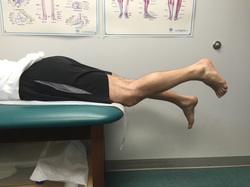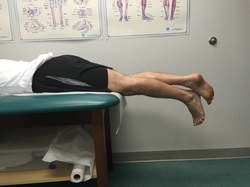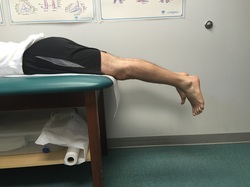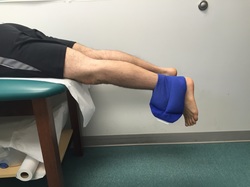|
I previously discussed how important it is to regain full knee extension following total knee replacement. Full knee extension is required for a normal, low energy gait cycle. Anterior knee pain can occur for a variety of reasons, but lack of full knee extension (otherwise known as a knee flexion contracture) will overload the patellofemoral joint (knee cap and femur joint) causing pain. Unfortunately, regaining knee extension after total knee replacement is generally challenging and often uncomfortable. I previously discussed the basic stretches I commonly recommend. Today I demonstrate the prone hang technique. This method uses gravity and relaxation to gently and progressively induce full knee extension.  Knee flexion contracture in prone position Knee flexion contracture in prone position Here I am lying on my stomach. My left knee (closest to the viewer) is held slightly flexed. This demonstrates the appearance of a knee flexion contracture. Remaining in this position for long periods of time (a minimum of 10 minutes 6 times per day) will result in gradual correction of the flexion contracture. The longer you remain in this position the better. Ideally you would spend a half-hour or more in this position several times each day. A long duration, gentle stretch will allow the viscoelastic biologic tissues to elongate.  Prone hang technique with additional force provided by opposite leg Prone hang technique with additional force provided by opposite leg By placing my opposite foot on the back of my heel and relaxing, my left knee is pushed into a more extended position. In this case, my right leg provides additional weight, helping gravity force my left knee straight. This may be necessary for more resistant cases of knee flexion contracture.  Prone hang technique with full knee extension achieved Prone hang technique with full knee extension achieved This is the goal. Full, symmetric extension of both knees.  Prone hang technique with additional force provided by sandbag or ankle weight Prone hang technique with additional force provided by sandbag or ankle weight Here I have placed a sandbag on the back of my ankle to provide additional extension force to my left knee. An ankle weight would also work nicely. Remember, the goal is to relax and allow the soft tissues (posterior capsule) to progressive elongate. This takes time. I recommend spending at least 10 minutes in this position several times per day. Longer is better, and will result in faster gains. Remaining in this position for 30-60 minutes at a time is challenging but ideal. Time and effort spent regaining full knee extension after total knee replacement will result in better knee function and reduced knee pain for the life of your knee replacement. As with all the stretching techniques I recommend, gentle, progressive, long-duration stretches. Cycling or bouncing the stretch is not necessary and probably irritating/counterproductive. Try to relax as much as possible during the stretch. Remember that some increased pain during and immediately after stretching is normal and expected.
The sooner you are able to regain full knee extension following total knee replacement the better you will feel, the easier your rehabilitation will be, and the more rapid the restoration of an efficient gait cycle. google-site-verification: googlee8ce9aaf537c901b.html
26 Comments
Vanessa
1/19/2021 11:02:07 am
I am 8 weeks post-op right TKR. Unfortunately I was one of the last to receive surgery in the UK before elective surgeries were stopped due to the pandemic. As a result I have been seen twice by a physiotherapist (at 2 weeks and 4 weeks) who then discharged me. I have had no follow up visits with my surgeon.
Reply
1/26/2021 11:44:31 pm
If you are still unable to perform a full revolution on a stationary bike at 8+ weeks from surgery, I think you should seriously consider speaking with your surgeon about manipulation under anesthesia at this point. There might still be a small window of opportunity to salvage your knee. The alternative would involve arthroscopic surgery, with lysis of adhesions (cutting of scar tissue) followed by manipulation. Generally, I recommend a manipulation around 6-8 weeks, any farther from surgery generally requires the arthroscopic procedure.
Reply
Enzo New York
6/6/2021 09:47:55 am
I am 12 weeks post op. I have a lot of stiffness and swelling in my knee. I can get above 120 but am still about -2. I can push my knee to zero. If I am up and about walking for about 30 minutes I need to sit because of pain in my knee. It has a lot of swelling. The top of my knee is very sensitive. When get up in the morning it feels like I need to start over to get my knee back to what I achieved the previous day. My Dr to told my to concentrate on stretching not strengthening. Is this normal?
Reply
6/23/2021 09:05:20 pm
It is not unusual for patients to struggle with the last couple of degrees of extension. If you keep working on the stretches I have shown in the preceding article, you will very likely get the last couple of degrees. It is not typical for a patient to have a significant amount of pain from a very slight flexion contracture like you describe. Usually once you regain a functional range of motion, and then ease up so you simply maintain that motion, your knee will calm down, the inflammation will resolve, and you will experience much less pain. You should be very close to this point with what you describe.
Reply
Leslie
8/20/2021 10:48:47 am
I had tkr on my left knee 7.5 weeks ago. Both knees were bone on bone. Now of course only right knee is. Post surgery my left knee extension was not good but flexion is excellent. I have done this extension exercise at home and at PT, now with 1 lb weight. Extension is now at 0• in left knee but not in right. Do you think this will be an issue for walking, say a mile or two? Do you think doing this and other extension exercises could increase the extension of my right knee? Since it is bone on bone, could doing extension exercises for right knee harm it? The surgeon wants to hold off evaluation for tkr of right knee at least a year. He said my new left knee may be enough although he had at first thought tkr for right knee would be needed.
Reply
9/1/2021 04:02:53 am
Once an arthritic knee loses motion, stretching will not help. Temporarily walking with asymmetric range of motion is generally well tolerated. It is crucial to prevent your new knee to revert to the poor range of motion in your arthritic knee. If you were my patient (and your recovery after your first knee replacement was good) I would offer you surgery in your other knee 3 months following your first surgery. There is not much to be gained by delaying surgery (assuming you arthritis is symptomatic) for much longer than 3 months, particularly if you have lost a significant amount of motion already.
Reply
Pam
8/28/2021 08:02:20 pm
Thank you for these detailed articles. The methods you outline are very different from what our hospital rehab is doing. I'd call it organic. I wish I had a table at home.
Reply
9/1/2021 03:30:52 am
Total knee prostheses are capable of range of motion indistinguishable from a normal knee with appropriate implantation and optimal rehabilitation. Unfortunately "perfect" rehabilitation is very rare. Even with typical rehabilitation most patients regain normal gait such that an observer would not know that they had an artificial knee. Many people have the ability to hyperextend their knees prior to developing arthritis. Surgeons generally try to avoid any tendency to allow hyperextension of a total knee replacement, as this could result in progressive hyperextension as the posterior soft tissues stretch out. This could be the reason you observe some asymmetry.
Reply
Vincent O'Hare
6/19/2022 11:34:13 am
Hi Christopher
Reply
6/29/2022 12:43:22 pm
If you have not regained full extension at this point I would definitely encourage prone hang technique. If you already have full extension, it is not necessary.
Reply
Linda Nickerson
7/7/2022 05:08:46 pm
I am 5 weeks postop and have achieved 0 extension and 117 flexion, but I am still so stiff. I am walking with no cane, no walker, and no limp. I am frustrated at the amount of stiffness I have with that amount of flexion. I can slowly do rotation on stationary bike. Should I be progressing more?
Reply
7/8/2022 07:39:30 pm
Your experience is not unusual for this stage postoperatively. This will improve with time. I would recommend you continue long duration stretching, and ice.
Reply
darrex
9/23/2023 05:18:43 pm
Hello i had condroblastoma for 2 years and i couldnt extend my knee since that. My cartilage isnt damaged, but im having serius issue with extension and flexion i cant close or extend my knee after around 130-140 im 16 years old i had surgery 2 months ago, will i be able to regain extension and flexion? And what should i do im doing exercises at home, with elastic band to maybe try to extend for a bit they extend To maybe 145 but go back to same 130 after closing knee for 2 minutes
Vincent O'Hare
7/8/2022 07:57:01 pm
Hi Linda
Reply
Linda Nickerson
7/9/2022 02:09:08 pm
Thank you for the feedback Vincent. I feel as though I've hit a minor wall with the swelling and flexion. I'm hoping it's temporary. My PT keeps reminding me of the trauma our knees underwent and that I need to be patient. As an athlete, that's very difficult. My knee feels good after stretching, but when I ice, I feel like it goes back to ground 0 again and is stiff. But everyone says ice, ice, ice!! I also have pain above my upper kneecap and tightness which PT also thinks could be a bit of scar tissue that they are trying to work out. It's nice to know I'm not alone :) Good luck with your continued rehab and hopefully in a couple months, you'll be walking like a champ !!!
ahmed hosny
8/15/2022 09:09:37 am
hello, i had and ACL surgery last october at 12/10/2021, now iam running and making strength exercises at the gym and had done footwork and jumping also, also i had the full range of motion for bending but extension i had zero extension, i almost have one or two degree away from my normal leg,the problem is when i make the prone leg knee extension exercise i got this one degree but when i go walking in the house it goes away and i start the exercise again as it didnot come in the first round of exercise so what is this and also i have a problem when i remain bending my leg too much as iam sleepng or while iam driving, i found it hard to full extend my leg it remain stiff for sometime and then go back normally but lacking this one degree of extension so can you help me please at this situation !
Reply
8/28/2022 10:20:30 pm
If you are only lacking 1 degree or 2 at this stage, I would just continue stretching as you have been doing. Prone hang is best. However, if you end up lacking a degree or two, this is actually a bit protective with regard to your new ACL, so I would not recommend getting too stressed out about it.
Reply
Jerry Wooldridge
8/22/2022 10:48:43 am
I am 3 wks postop TKR and can’t tolerate the knee bending pain from phy therapy. I had (PMR) Polymyalgia Rhumatica yrs ago, and the pain from therapy has activated the PMR. After phy therapy I have serious flu like symptoms, nauseam, and serious pain in the new knee, ankles, shoulders and excruciating sciatic nerve pain on the replacement knee leg. Can anyone recommend what I can do to get through this situation? Please let me know if anyone else has experienced this problem.
Reply
11/4/2023 05:12:02 pm
Sounds like a stress dose steroid could have helped you. I apologize for missing this comment when it probably mattered much more to you. I hope your rehab went OK after you commented.
Reply
Catherine Locke
9/8/2022 11:28:35 am
I am 11 weeks and continue to struggle with my extension. This was not an all a challenge with my other TKR so I was not expecting such a struggle. I am now able to get full extension after stretching however after I finish stretching it seems to recoil by a few degrees. I am now doing this extension suggestion on my stomach with a 5 pound ankle weight for 10 minutes several times per day. 10 minutes is the most I seem to be able to handle and is very painful by the end. At night I am still unable to sleep on my back without a small pillow behind my knee again due to the pain. I am working hard on extension daily and seeing gains but as I say, it seems to always recoil back to slightly bent. In your opinion am I still on track or do I need to up my game? My flexion has come a long well and I can achieve 145 after warming up. Thanks so much for all your great advice and information. It has been so helpful to have access to right from the beginning of my 2nd TKR.
Reply
9/17/2022 08:13:59 am
First off, 145 degrees of flexion is phenomenal! You've obviously been working hard. I would try to avoid sleeping with the pillow behind your knee- that will contribute to a flexion contracture, like you describe, and make subsequent progress more challenging. I know it hurts, but (in my opinion) the pillow behind the knee is really counterproductive. Can you use some ice/heat/anti-inflammatory/pain medication before bed so you can sleep without the pillow? I might even suggest using a hinged knee brace to lock your knee straight while sleeping. This would avoid the recoil that seems to be occurring and will most likely allow you to lock in your gains. Best wishes for ongoing recovery!
Reply
Esther Hayes
9/15/2022 09:14:35 pm
I had TKR 10 wks ago. I am unable to bend my knee back without pain and it does not go all the way. My knee is still swollen and I am constantly in pain. Is this normal? sometimes the inside of my knee hurts like a shooting pain going through it.
Reply
9/17/2022 08:17:18 am
While some swelling and discomfort is expected even at post-operative week 10, when properly rehabilitated, the knee should be starting to calm down by then. The key is early, effective stretching exercises. Now, at week 10 it may be very difficult or impossible to obtain an excellent result if you are significantly behind schedule. Without any more details on your motion/rehabilitation progress, I can not provide any specific advice. I would recommend following up with your surgeon for evaluation.
Reply
Gabrielle
1/26/2024 08:00:38 pm
Hi! My PT made me do this exercise with 13 pounds for 5 minutes and I feel like something went wrong :( I feel like 13 pounds was excessive, I am a 114 pound female. Do you think 13 pounds was excessive? It has cause me pain I didn't have before (I was woken up at night by pain after this).
Reply
3/17/2024 07:23:37 pm
I might have preferred lighter weight for longer duration. Hopefully it helped you regain full extension (which is extremely important). I highly doubt any permanent harm was done.
Reply
Gabrielle
1/26/2024 08:02:16 pm
Just wanted to mention in addition to the previous comment that I didn't have knee replacement, I have fat debridement for Hoffa's syndrome.
Reply
Your comment will be posted after it is approved.
Leave a Reply. |
Dr. GorczynskiOrthopedic Surgeon focused on the entire patient, not just a single joint. Categories
All
|

 RSS Feed
RSS Feed